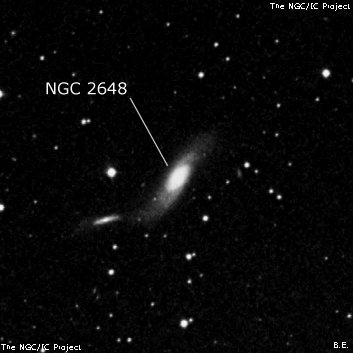
William Herschel discovered NGC 2648 = H III-49 = h521 = h3135 on 19 Mar 1784 (sweep 177) and recorded "F, S, with a nucleus. I had some doubts but 240 confirmed the reality." On 18 Mar 1786 (sweep 538) he logged "F, lE from np to sf, cS. Almost like two joined together." John Herschel reported from South Africa, "pB; lE; psmbM; precedes a star 10m."
R.J. Mitchell, observing with LdR's 72" on 23 Feb 1857, described NGC 2648 as "E np sf, mbM." In addition he noted and sketched a second nebula, "I think Alpha is a very faint ray though likely to be taken at first for a star." The diagram clearly reveals that Alpha -- drawn as a small nebula extending WNW-ESE -- is CGCG 060-036 = PGC 24469. The full description and sketch was not included in LdR's 1861 monograph, so JH was unaware when he compiled the GC and Dreyer skipped CGCG 060-036 when compiling the NGC.
400/500mm - 17.5" (2/1/92): moderately bright, fairly small, elongated 5:2 NW-SE, small very bright core. Located 1.9' W of a mag 10.5 star.
600/800mm - 24" (4/28/14): moderately to fairly bright, moderately large, elongated 5:2 NW-SE, sharply concentrated with a very bright core, 1.5'x0.6'. A mag 11 star lies 1.9' E of center. Forms a pair (Arp 89) with edge-on MCG +02-22-006 2.4' SE. The companion appeared very faint, small, elongated 5:2 WNW-ESE, ~25"x10", low even surface brightness.
900/1200mm - 48" (2/21/12): very bright large spiral, elongated ~5:2 NNW-SSE, ~2.4'x0.9'. Contains a large, very bright core that increases to a stellar nucleus. Forms an interacting pair (Arp 89) with MCG +02-22-006 2.4' SE of center. NGC 2648 has an asymmetric appearance with the south-southeast arm stretched into a faint tidal tail. The brighter portion of the arm extends south-southeast of the core (in the direction of the major axis), but a faint thinner extension curves and sweeps east, fading out just before connecting with MCG +02-22-006. A mag 11 star is 1.9' E.
The companion appeared moderately bright, edge-on 5:1 WNW-ESE, 1.0'x0.2', sharply concentrated with a very small, bright nucleus. The system was classified by Arp under "spiral with a large high surface-brightness companion on arms".
Notes by Steve Gottlieb